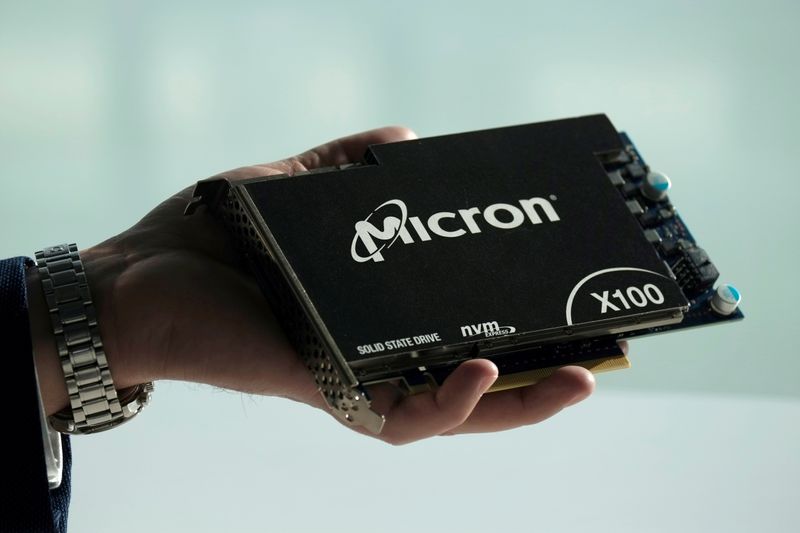Street Calls of the Week
On Wednesday, JPMorgan provided insights on Micron Technology’s (NASDAQ:MU) performance following the company’s morning conference presentation. Analysts at the firm noted that Micron’s manufacturing and technology advancements are progressing as planned, with demand trends for both DRAM and NAND memory remaining robust, particularly in datacenter applications. The observed pricing inflection, which aligns with previous forecasts and a customer notice from late March, suggests a favorable market for Micron. According to InvestingPro data, Micron is currently undervalued, with strong financial health metrics and a market capitalization of $107.8 billion.
Micron is experiencing a strong demand in the datacenter sector, driven by AI and accelerated computing needs, which in turn is fueling the demand for high-bandwidth memory (HBM) and datacenter solid-state drives (SSDs). Consumer applications, including smartphones and PCs, are also showing a positive demand trajectory in the May quarter as inventories stabilize. This momentum is reflected in Micron’s impressive 71% revenue growth over the last twelve months to $31.3 billion, with analysts forecasting 41% revenue growth this fiscal year. This trend is expected to continue, with no current signs of disruption from potential tariff-related issues affecting the second half of the year.
The company is making headway with its HBM3E 12-hi ramp, which is integrated into NVIDIA (NASDAQ:NVDA)’s GB300, with yields and volumes on track. The crossover from 8Hi to 12Hi memory stacks is anticipated to occur in the third quarter of 2025, with the 12Hi learning yield rate surpassing that of the 8Hi. These developments are in line with expectations for yield improvements, cost reductions, and overall ramp execution. InvestingPro analysis reveals two key insights: Micron trades at an attractive P/E ratio relative to its near-term earnings growth, and analysts expect significant net income growth this year. For more detailed analysis and additional insights, check out Micron’s comprehensive Pro Research Report, available with an InvestingPro subscription.
Micron’s disciplined approach to supply expansion is also highlighted, with a particular focus on legacy DDR (NYSE:SITC) applications in China. The team is carefully considering these supply additions in their strategic planning. In the high-bandwidth memory market, Micron is positioning itself to benefit from the aggressive product cadence of the XPU rollouts, believing that technology market leaders will have an edge.
Overall, JPMorgan’s comments reflect confidence in Micron’s direction, with strong demand for its products and successful progress in manufacturing and technology node advancements. The company’s focus on high-value and high-end applications is aligned with the industry’s move towards AI and accelerated computing, which is expected to drive continued market share gains, particularly in the datacenter SSD segment.
In other recent news, Micron Technology has maintained its financial guidance, which was revealed during the 53rd Annual J.P. Morgan Global Technology, Media and Communications Conference. This decision has left some investors concerned, as they were anticipating an updated forecast. Meanwhile, TF International Securities analyst Ming-Chi Kuo projects that Apple (NASDAQ:AAPL)’s upcoming iPhone 17 models will feature 12GB of DRAM, potentially benefiting suppliers like Micron. Additionally, Rosenblatt Securities has expressed optimism for the memory industry, highlighting favorable demand drivers and a positive outlook for Micron and Rambus Inc (NASDAQ:RMBS).
Micron has also announced a restructuring into four new business units to capitalize on AI-driven market growth. The reorganization is expected to be completed by May 2025, with financial reporting under the new structure starting in the fourth fiscal quarter of 2025. Furthermore, JPMorgan has commented on Micron’s limited exposure to China’s regulatory restrictions, emphasizing the company’s resilience amid these challenges. Despite the restrictions, there remains a significant demand for AI in China, which could benefit Micron in the long term. These developments reflect Micron’s strategic positioning and adaptability in the evolving global technology landscape.
This article was generated with the support of AI and reviewed by an editor. For more information see our T&C.
